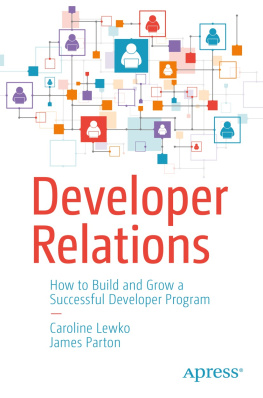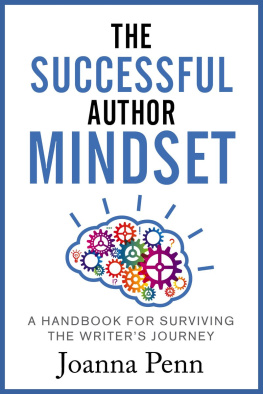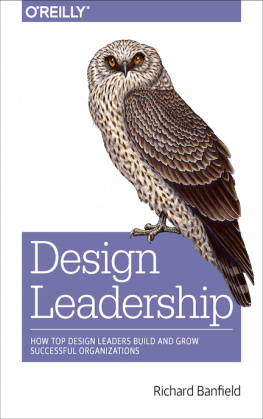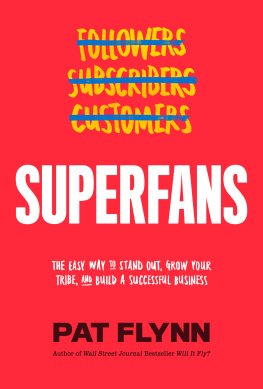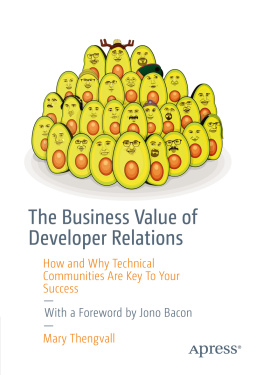Caroline Lewko - How to Build and Grow a Successful Developer Program
Here you can read online Caroline Lewko - How to Build and Grow a Successful Developer Program full text of the book (entire story) in english for free. Download pdf and epub, get meaning, cover and reviews about this ebook. publisher: Apress, genre: Romance novel. Description of the work, (preface) as well as reviews are available. Best literature library LitArk.com created for fans of good reading and offers a wide selection of genres:
Romance novel
Science fiction
Adventure
Detective
Science
History
Home and family
Prose
Art
Politics
Computer
Non-fiction
Religion
Business
Children
Humor
Choose a favorite category and find really read worthwhile books. Enjoy immersion in the world of imagination, feel the emotions of the characters or learn something new for yourself, make an fascinating discovery.
- Book:How to Build and Grow a Successful Developer Program
- Author:
- Publisher:Apress
- Genre:
- Rating:5 / 5
- Favourites:Add to favourites
- Your mark:
- 100
- 1
- 2
- 3
- 4
- 5
How to Build and Grow a Successful Developer Program: summary, description and annotation
We offer to read an annotation, description, summary or preface (depends on what the author of the book "How to Build and Grow a Successful Developer Program" wrote himself). If you haven't found the necessary information about the book — write in the comments, we will try to find it.
How to Build and Grow a Successful Developer Program — read online for free the complete book (whole text) full work
Below is the text of the book, divided by pages. System saving the place of the last page read, allows you to conveniently read the book "How to Build and Grow a Successful Developer Program" online for free, without having to search again every time where you left off. Put a bookmark, and you can go to the page where you finished reading at any time.
Font size:
Interval:
Bookmark:


This Apress imprint is published by the registered company APress Media, LLC part of Springer Nature.
The registered company address is: 1 New York Plaza, New York, NY 10004, U.S.A.
Caroline:
To Mom and Dad (posthumously) for letting me carve my own path.
To Alain, my spicy frog, because its already been discussed.
James:
To my parents for their love, security, and patience.
To Michelle, Jacob, and Holly everything is for you and because of you. x
Without you, this book wouldnt have been possible:
Anik Bukta illustrations
Phil Leggetter technical reviewer
Dana Fujikawa for his big red pen
Carlo Longino (posthumously) a key contributor of many of the early DevRel frameworks and ideas
Thank you for your contributions and support:
Andrew Oliver, Jason Nassi, Russell Buckley, Ameer Badri, Jon Bradford, Matthew Revell, Thayer Prime, James Governor and the Flyless community, Judy Hamilton, Rod Burns, Ana Schafer Muroff, John Denniston, Bear Douglas, Stephen Millard, Suzanne Nguyen, Anthony Fabbricino, Bryce Keane, Ben Blume, Martin Isaksson, Steven Pousty, Linda Streb, Desigan Chinniah, Rand Hindi, Ben Gamble, Andreas Constantinou and the SlashData team, Tony Fish, Chrysanthos Chrysanthou, Jake Ward, Tyler Jewell.
There are hundreds more. Thank you one and all.
In the 1990s, Java was a young, exciting programming language that made it possible to write portable applications easily. I was overjoyed and spent the better part of the six years after university graduation training, educating, and promoting this world-changing technology to anyone who would listen.
These efforts were given a platform (and at the time an amplifying megaphone) at BEA Systems, the market leader in Java application servers, where I carried the title of Chief Evangelist. Developers, at the time, were seen as fickle, idiosyncratic, and with low influence authority in the IT decision-making structure.
Little did I know that evangelism was how early technology companies were establishing a Developer Relations function. At the time, we were thrilled when developers attended our workshops to acquire new skills or when our articles outlining innovative techniques in Java programming were published in hip trade magazines. Evangelism was, in many respects, fun because while we were spreading essential technology insights, it kept our own knowledge growth curve piqued.
In the following 20 years, developers have become an economic force. Businesses that build products sold to or consumed by developers generated $40B in 2020 annual recurring revenue, putting developers at the center of the multitrillion-dollar IT industry. More than 1200 companies have created commercial products within this landscape, and its growing 19% annually. With more than 20 million professional software engineers, and 250 million knowledge workers transitioning into civilian developers through low-code technology, the influence of developers will be increasingly as important as advertising in the Super Bowl or the reach of TikTok.
Developer Relations has emerged as the professional practice by which organizations build sustainable and endearing relationships with developers in their new role as economic influencers.
The industrys understanding of Developer Relations is in its infancy. Only 24% of the Fortune 500 companies have established developer program management offices, and cursory scans of job boards show DevRel positions available in only the best-funded venture capital technology startups. And, in the companies that Ive invested in, only one third have established DevRel programs even though its always highlighted as essential in the boardroom!
When Caroline Lewko told me that she was combining her and James Partons many years of Developer Relations experience into a book that outlines a recipe for creating, building, and growing a Developer Relations group, I knew that their efforts would have a profound and lasting impact upon marketing, product, and customer success organizations.
Well-run DevRel groups have a significant impact on the bottom line. By reaching developers to facilitate solving their technology problems, businesses can expect a lower customer acquisition cost, lower support costs which improve gross margins, and lower customer churn rates improving the net retention rate.
In Developer Relations, How to Build and Grow a Successful Developer Program, Caroline and James provide a blueprint for organizations to build high-performing DevRel organizations.
In Part I: Develop a Common Understanding, they define Developer Relations and articulate how it is different from B2B and B2C techniques by laying out a framework that combines education, marketing, experience, and success, and emphasize the value of the Developer Economy.
The definition of a developer changes with the nature of technology, and with low-code systems making nearly every knowledge worker a developer, there may be up to 500 million reachable professional developers in the coming decade. In Part II: Key Differentiators, Caroline and James provide the constructs necessary to define, segment, and identify different categories of developers, and the companies they work in, which inform the nature of how your marketing and education investments will be made, and the type of monetization strategy you might deploy.
Developers as buyers are more likely to buy from companies implementing a Product-Qualified Lead motion rather than the traditional, sales-heavy Sales-Qualified Lead process. In Part IV: Go-to-Market, Delivering Your Strategy, Caroline and James codify the PQL experience from discovery through activation and scaling. It delves you into the mindset of the developer to help you address key questions that must be addressed at every stage of engagement with developers. Combined with Part III: Alignment on Goals, they also emphasize, whether its a Product-Qualified Lead or a Developer Relations Qualified Lead, the importance of collaborating with the sales and other teams inside your organization.
Font size:
Interval:
Bookmark:
Similar books «How to Build and Grow a Successful Developer Program»
Look at similar books to How to Build and Grow a Successful Developer Program. We have selected literature similar in name and meaning in the hope of providing readers with more options to find new, interesting, not yet read works.
Discussion, reviews of the book How to Build and Grow a Successful Developer Program and just readers' own opinions. Leave your comments, write what you think about the work, its meaning or the main characters. Specify what exactly you liked and what you didn't like, and why you think so.

